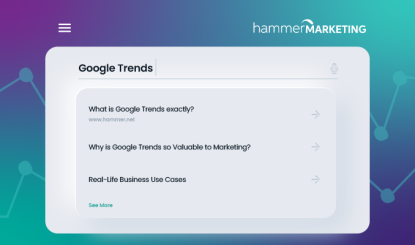Google Trends: Digital Marketing’s Most Underrated Upper Hand
Google’s market dominance is no secret. The search engine receives eight and a half billion queries daily, making its inner workings a goldmine of insight into what people worldwide are asking, wanting, and thinking. Imagine pulling back the proverbial curtain and seeing it all – what’s top of mind at any given moment, in any place, as evidenced by internet searches.
You can. It’s called Google Trends.
And maybe the wildest part: Very few marketers are using it.
WHAT IS GOOGLE TRENDS EXACTLY?
Around since 2012, Google Trends is a minute-to-minute look at Google search queries for trending search terms, yes, but also any search term. Line graphs and shaded maps reveal what people are searching for, in real time and dating as far back as 2004.
It gets better. Google Trends also offers search term volume and trends by location (including subregions) and language, giving attentive users an easy and authoritative look at how search interest shifts within, and differs among, various regions over time. An armchair sociologist can have a field day on Google Trends, examining ebbs and flows for any imaginable topic. It’s another population, though, for whom Google Trends is pure gold:
Marketers.
WHY IS GOOGLE TRENDS SO VALUABLE TO MARKETING?
It probably goes without saying: Access to interest in a particular topic in a particular place at a particular time can dramatically boost market research and keyword targeting that’s instrumental to effective marketing in 2024.
And beyond its face-value functionality, Google Trends’ advantages keep coming:
- Intuitive and easy to use. Know how to use Google? You’re halfway to Google Trends literacy. Trends Help can get you across the finish line.
- Free. Yup. Whereas competing and popular insight tools like Semrush come at a premium, Google Trends is a no cost opportunity to glean similarly valuable and comprehensive insight.
- It’s underutilized – which gives you an edge. With Google Trends, you’re not only using a different data set than most other marketers (who tend to favor Semrush), but one that’s potentially more accurate given data is sourced directly from Google.
- Many metrics. Google Trends results can be searched along four lines: location, time period, category, and web search (Image search, YouTube Search, and so on). When harnessed, these metrics offer a staggeringly in-depth understanding of user behavior.
Google Trends features worth noting:
- The Explore tab in the main navigation bar lets you compare the performance of up to five different search terms across metrics. Who’s more popular, Mary-Kate or Ashley? Now you know.
- “Related queries” shows popular searches similar to the one you’re examining; our digital marketing team sorts results by top and rising.
- Subscribe to trend alerts that let you know when search terms relevant to your interests start surging.
REAL-LIFE BUSINESS USE CASES
I was personally introduced to Google Trends not at work but at a brew pub, more than a decade back. My buddy started telling me how he was considering a golf cart shield business but still needed to so some more market research. He pulled up Google Trends and typed “golf cart shields” into the search bar; it turns out very few people nationwide had ever searched this phrase. He narrowed his query down to “golf carts” and started seeing search volumes in warm weather climates. However, only when he drilled down to Florida did he see a high volume of searches for golf carts – leading him to conclude that golf cart shields were just too niche to justify an investment.
For me, the experience resonated. In the span of a happy hour, I became one of a very small number of marketers at the time harnessing Google Trends for marketing good. To this day, I extol its virtues to digital marketing agency peers and business owners alike. Here are a few ways that Google Trends can benefit business:
- SEO boost. Say your digital agency wants its Pennsylvania-based law firm client’s website copy to align which what people in that state are searching – a win for common sense and SEO. Use the comparison feature on the Explore page of Google Trends to compare searches for differing descriptions of the same service – “drug charges” versus “drug cases,” for example – to see the standard vernacular for that region.
- Investment decisions. Imagine you’re an entrepreneur who recently moved to Colorado. You wonder if the region can support a new Hyundai dealership. Geographic search filters reveal which automotive brands are popular in your area – possibly an indication of demand.
- Product positioning. An e-commerce flower supplier looking to make the most of Mother’s Day isn’t sure whether to plug flower delivery or gift baskets more heavily this year. By looking at search volume for both of those terms during the month of May last year, she can see what people searched for; opening up the last five years shows national trend data that also helps her decide which option buyers might want most.
- Relocation choices. A custom ice sculptor’s work has declined in recent years; he wants to move to wherever the ice sculpture scene is (ahem) hottest. By starting with basic search terms, he can continue to refine his filters, moving from “worldwide” to specific countries, then to specific states and provinces within each to find the epi-center of ice sculpture-related searches.
- Top of funnel content ideas. A fitness coach wants to blog about diets in efforts to attract new visitors to his website and social media platforms. This starts by knowing which diets are trending. By using a one-word search phrase – “diet” – on Google Trends, applying date-related filters, then reviewing related query breakout terms provided, he can create a hyper-relevant content calendar in-step with diet trends.
- Sales focus. A digital agency owner wants to know which of its four services – SEO, digital marketing, Google ads, or email marketing – deserves the greatest sales focus. By comparing digital marketing search terms in the county where the agency is based, she can see how search volume compares for each one.
- Specialization. An e-commerce consultant aims to niche down to just one shopping platform. Magento, Shopify, Big Commerce, WooCommerce – which is most likely to generate short-term and long-term ROI? By comparing search volume in the last 90 days and the last 5 years, he gains vast insight into their relative popularity among Google users. His decision aligned with the results: Shopify!
Of course, digital marketing consists of much more than what Google Trends alone can provide. Is your business looking for an agency that offers forward-thinking strategies and tools along these lines, and who can leverage Google Trends on your behalf? Look no further than Hammer Marketing. Drop us a line or swing by for a visit today!

